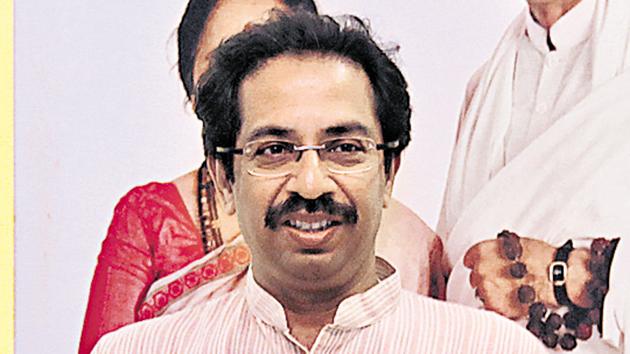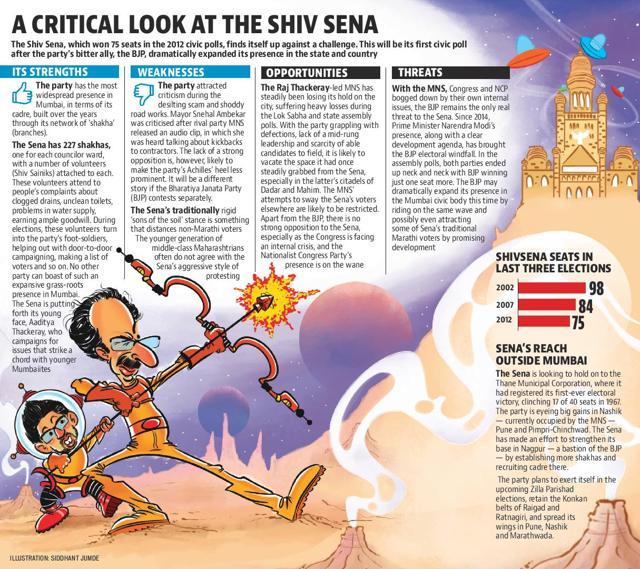Shiv Sena gears up to guard its citadel
Even as seat-sharing talks with the BJP are on, the party is preparing to contest solo, if need be
This is not the first Mumbai civic election the Shiv Sena is contesting. Neither is it the first civic election when the Sena is in power. The party has ruled the Brihanmumbai Municipal Corporation (BMC) for three decades since 1985, barring four years (1992-96).

Since 1997, it has held on to its vote share in Mumbai’s municipal wards and to its position as the largest party in the municipal council.
Despite all this, the civic polls this year are more significant for the Shiv Sena than the previous ones. There is more at stake than just retaining control of the city.
The election on February 21 is Mumbai’s first civic poll after the Sena’s bitter ally, the Bharatiya Janata Party (BJP), dramatically expanded its presence in the state and the country, riding on Prime Minister Narendra Modi’s popularity and talk of a gleaming development agenda. It is the first election since 1992 when the Sena is facing a serious challenge, that too from an ally, not a rival.
This is also the first BMC election that Uddhav Thackeray will lead the Shiv Sena by himself, without the towering presence of his father Bal Thackeray who founded the party. With much to prove, Thackeray is leaving no stone unturned.

With the Congress in Mumbai not looking strong as yet, the NCP’s influence on the wane and the MNS in crisis, it is BJP that is the Sena’s prime competition. The BJP, which has been the Sena’s junior partner in the BMC so far, is eyeing exponential growth in Mumbai.
The Sena cannot risk the BJP growing to be an equal in the BMC, for this would hurt not just the Sena’s bargaining power at the state level, but also Thackeray’s leadership credentials.
Even as seat-sharing talks are on, with relations having grown frosty of late, the Sena is preparing the ground to contest solo, if need be.
Though it had won the mayorship earlier, the Shiv Sena first wrested control of the BMC in 1985, winning 75 seats, after a campaign harping on Mumbai and the ‘Marathi manoos’. More than 30 years later, the party is trying to soften its hardcore pro-Marathi ‘sons of the soil’ image and paint a more inclusive picture, reaching out to Mumbai’s non-Maharashtrians, especially Gujaratis and North Indians.
Traditionally in the saffron alliance, wards in Mumbai’s Marathi-dominated areas would be contested by the Shiv Sena, while the Gujarati and North Indian-dominated wards would go to the BJP. The city’s Gujarati community has thus far been mostly loyal to the BJP, while the North Indian votes usually split between the BJP and the Congress.
The Sena’s started visibly reaching out to the BJP’s core voter base in September last year when the party put up posters in Ghatkopar, a largely Gujarati-speaking suburb, in the Gujarati language to woo the community ahead of the release of the state’s housing policy. The party later inducted Gujarati leaders such as Hemraj Shah from the Bruhad Mumbai Gujarati Samaj, Rajesh Doshi, deputy head of the BJP’s Gujarati wing from Kandivali, producer Tejas Gohil and others. Constantly taking on the Narendra Modi-led government over demonetisation, the Sena is also attempting to tap the angst in Mumbai’s business community, mostly comprising Gujaratis, against the move.
Abhishek Ghosalkar, a Shiv Sena corporator from Dahisar, organised a Chhath Puja this year in his area, which has a significant North Indian population. “We are pro Mumbaiites. Our motto is that whoever lives in Mumbai is a Mumbaiite. That was Bal Thackeray’s statement too right from the beginning, but over the years people developed a sort of misunderstanding about the Shiv Sena. So, some communities are disappointed with us. We are only reaching out to them now and making that extra effort at telling them that we have always been inclusive,” Ghosalkar said.
In the 2014 assembly polls when the BJP and the Shiv Sena contested solo after more than two decades of a pre-poll alliance, it was the BJP that had the last laugh in Mumbai, winning one constituency more than the Shiv Sena. Senior Shiv Sena leaders such as Subhash Desai, Vinod Ghosalkar, and Mangesh Satamkar had to cede their strongholds to relatively younger and inexperienced BJP candidates.
The party’s immediate priority is to change that equation, be one-up on the BJP in Mumbai, and stamp its influence on areas such as Borivali, Dahisar, Goregaon, Sion Koliwada and Vile Parle, where the BJP triumphed during assembly polls, despite the areas having a significant population that has traditionally voted for the Shiv Sena.
Besides, the party will also have to focus on reclaiming Dadar and Mahim, traditionally bastions of the Shiv Sena that the Raj Thackeray-led Maharashtra Navnirman Sena snatched during the 2012 elections, dislodging the Sena from all seven councillor seats. Prior to that, the Shiv Sena had five of the seven wards.
The party first roared from Shivaji Park in 1966 where Bal Thackeray addressed his first Dussehra rally, an annual tradition since then. The party’s headquarters, Sena Bhavan, is a stone’s throw away.
However, it is a prestige issue for the MNS too.
Like the Shiv Sena, the MNS’ first rally was also at Shivaji Park when Raj Thackeray announced the party’s formation in 2006. It steadily ate into the Sena’s pie, getting a legislator elected from the constituency and wrenching control of all seven corporation wards in 2012.
However, just as quickly as the MNS tightened its grasp over the Dadar-Mahim belt before 2012, the area started to slip from the party’s hands, as it lost heavily in the following parliamentary and legislative polls to the Shiv Sena, which now hopes to improve on its performance. The Shiv Sena has even poached Prakash Patankar, the MNS’ zonal head for the Dadar-Mahim area, with his supporters, and is making a list of all its previously successful and influential leaders from the area such as Milind Vaidya and Vishakha Raut as well as sitting legislator Sadia Sarvankar’s son, Samadhan Sarvankar, as possible candidates to take on the MNS.
The Shiv Sena, which had the image of being conventional and rather stiff, is suddenly talking the language of an average young Mumbaiite who works hard, hangs out at cafes and restaurants, and lives half his or her life within the virtual confines of social media. The party had given up its opposition to Valentine’s Day a few years ago.
As per the latest Census data, around 50 per cent of the total voting population in India — 378.6 million out of 762 million — falls in the age bracket of 18 to 35 years. Even if the exact figure cannot be extrapolated for Mumbai, young voters are on the rise in the country’s maximum city too.
Over the last two years, the Sena has made a conscious effort to promote Aaditya Thackeray to attract young voters who were fascinated by MNS chief Raj Thackeray for some time.
The 26-year-old Thackeray scion was a major reason why the Shiv Sena stopped its protests against Valentine’s Day. He talks a language that most young Mumbaiites want to hear, pushing for a proposal for opening up Mumbai’s nightlife, reserving streets for artists and musicians, roping in personalities such as Dino Morea, Akshay Kumar and Alia Bhatt for his causes, and keeping up a regular dialogue with city’s young Twitterati.
The party’s latest election campaign comes with an English tagline — #Didyouknow — offering tidbits about everything that the BMC has been doing in the education, infrastructure, health and other sectors. It is a more youthful, cosmopolitan version of its earlier campaign tagline ‘Karun Dakhavla’ (We did it).
According to Arvind Sawant, Shiv Sena parliamentarian from South Mumbai, at least 30 per cent of Mumbai’s population is in the 18-35 age bracket. “The young voters were always with the saffron, and the Sena has always tried to take up their issues. But over a period of time their issues have changed. During Balasaheb Thackeray’s time, the concerns were employment, stability. Today, those concerns are to an extent redundant, and the younger generation craves for other things. The Shiv Sena is adjusting its vision and moving with the times,” he said.
Read
Can underdog Congress get its act together?
Congress to gherao four RBI offices on Jan 18 against note ban
Stay updated with all the Breaking News and Latest News from Mumbai. Click here for comprehensive coverage of top Cities including Bengaluru, Delhi, Hyderabad, and more across India along with Stay informed on the latest happenings in World News.
Stay updated with all the Breaking News and Latest News from Mumbai. Click here for comprehensive coverage of top Cities including Bengaluru, Delhi, Hyderabad, and more across India along with Stay informed on the latest happenings in World News.





